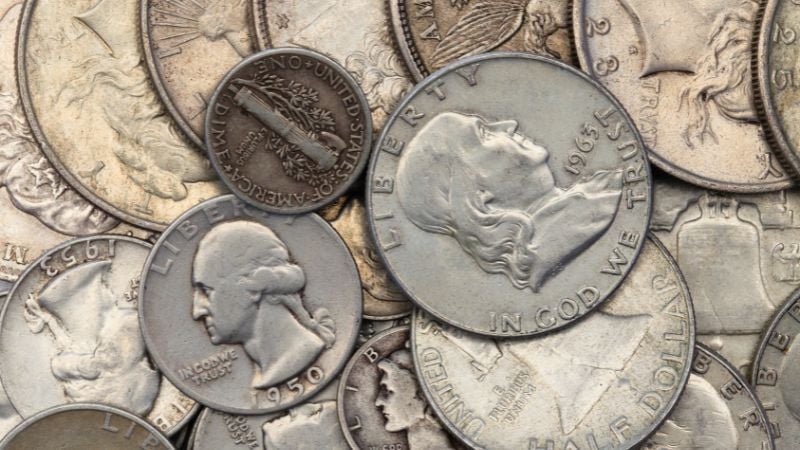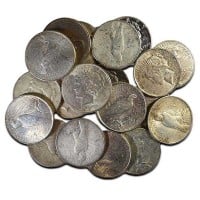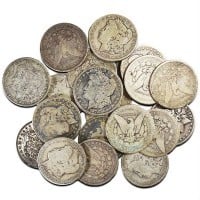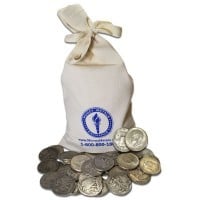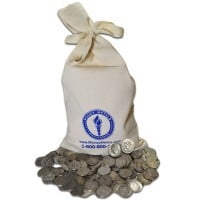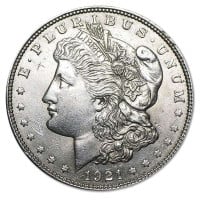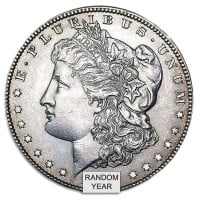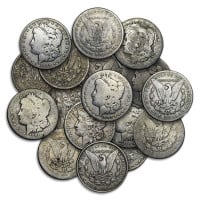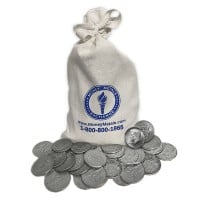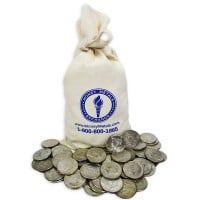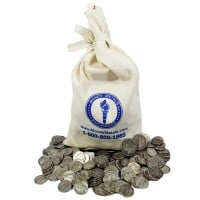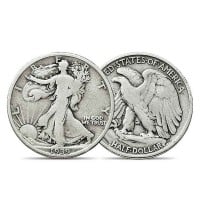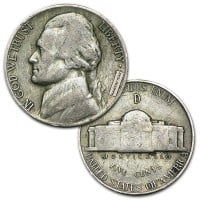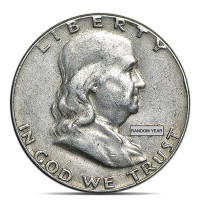Pre-1965 Junk Silver Coins (90%, 40%, & 35%)
| Qty | Price Each |
|---|---|
| 1 - 99 | $29.75 |
| 100 - 499 | $28.75 |
| 500 - 1999 | $27.75 |
| 2000+ | Call for pricing |
|
|
|
| Qty | Price Each |
|---|---|
| 1 - 99 | $31.25 |
| 100 - 499 | $30.25 |
| 500 - 999 | $29.25 |
| 1000+ | Call for pricing |
|
|
|
| Qty | Price Each |
|---|---|
| $ 5 Face | $113.00 |
| $ 500 Face | $11,120.00 |
| $ 2000 Face | $44,060.00 |
| $ 5000 Face | Call for pricing |
|
|
|
| Qty | Price Each |
|---|---|
| $ 5 Face | $108.70 |
| $ 500 Face | $10,695.00 |
| $ 2000 Face | $42,340.00 |
| $ 5000 Face | Call for pricing |
|
|
|
| Qty | Price Each |
|---|---|
| 1 - 99 | $35.25 |
| 100 - 499 | $34.25 |
| 500+ | Call for pricing |
| Qty | Price Each |
|---|---|
| 1 - 99 | $53.95 |
| 100 - 499 | $52.95 |
| 500+ | Call for pricing |
| Qty | Price Each |
|---|---|
| 1 - 99 | $32.25 |
| 100 - 499 | $31.25 |
| 500 - 999 | $30.25 |
| 1000+ | Call for pricing |
| Qty | Price Each |
|---|---|
| $ 5 Face | $118.35 |
| $ 500 Face | $11,660.00 |
| $ 2000 Face | $46,640.00 |
| $ 5000 Face | Call for pricing |
|
|
|
| Qty | Price Each |
|---|---|
| $ 5 Face | $43.40 |
| $ 1000 Face | $8,590.00 |
| $ 3000 Face | Call for pricing |
|
|
|
| Qty | Price Each |
|---|---|
| $ 5 Face | $120.50 |
| $ 500 Face | $11,875.00 |
| $ 2000 Face | $47,060.00 |
| $ 5000 Face | Call for pricing |
|
|
|
| Qty | Price Each |
|---|---|
| $ 5 Face | $118.35 |
| $ 500 Face | $11,660.00 |
| $ 2000 Face | $46,640.00 |
| $ 5000 Face | Call for pricing |
|
|
|
| Qty | Price Each |
|---|---|
| $ 5 Face | $187.95 |
| $ 50 Face | $1,851.00 |
| $ 250 Face | $9,115.00 |
| $ 500 Face | Call for pricing |
|
|
|
| Qty | Price Each |
|---|---|
| $ 5 Face | $118.35 |
| $ 500 Face | $11,660.00 |
| $ 2000 Face | $46,640.00 |
| $ 5000 Face | Call for pricing |

Many people want to begin investing in precious metals but do not quite know how to begin. With countless numbers of options and companies out there, it can become rather overwhelming for beginner investors getting started. Knowing how to get started and what to look for is going to help you save money, time, and frustration while maximizing your success potential.
Some common questions we hear from novice investors are, “How do I get started investing in silver?” “Why should I invest in precious metals such as silver?” “What silver products should I invest in?” “Should I buy rare silver coins?” “When should I buy or sell my silver?” “How much should I sell my silver for?”
To teach you how to get started investing in the precious metal commodity silver quickly and easily, we are going to cover what “junk silver” is, how to buy and sell silver, and common mistakes to avoid when investing in silver. Here are some highlights:
- Silver, especially junk silver, is a great way to get started investing in precious metals
- Junk silver is a way to own silver while saving money, time, and frustration when compared to other popular silver investment options
- In this post, we’ll explain what junk silver is, why junk silver is an important step when getting started investing in precious metals, explain how to buy and sell your junk silver, and provide 4 examples of junk silver if you are new
What is Junk Silver?
“Junk silver” coins are pre-1965 mint U.S. circulated coins (e.g. pre-1965 Roosevelt dimes, Washington quarters, Kennedy half dollars, etc.) that contain 90% silver, have no numismatic value, and are primarily bought and sold for their silver content. Some sellers and collectors may include silver dollars and 35%-40% silver coins under the junk silver umbrella term category.
Junk silver is not to be confused with “fine silver.” Junk silver contains 90% silver and usually 10% copper, whereas fine silver is 99.9% (also known as .999 silver, or 999). Silver itself is sometimes referred to as “poor man’s gold,” although silver is a fantastic lower-cost alternative to gold.
Other commonly associated terms used to describe junk silver include “90 percent silver,” “Old US silver,” and “Constitutional silver.”
However, Constitutional silver is more of a reference to sound money policy and the use of precious metals in coins as intended by the founding fathers and framers of the U.S. Constitution than with the commodity “junk silver,” per se. During the time of Independence, there was a more commonly shared understanding of what ‘money’ was to definitively be.
The term “junk silver” for coins began as a derogatory term, popularized throughout the 1970s and 1980s, to describe the undesirable conditions of heavily circulated silver coins in the U.S.. These, now, “junk” silver coins were being transitioned out of circulation for less valuable metals to replace the coins. This was from a period when the country was actively and publically debasing the currency removing it from shared precious metals commodities or bimetallism. Gresham’s Law suggests that bad money was driving out good money.
The silver in each coin was becoming increasingly valuable compared to the USD it represented, more than each coin’s face value. Banks and laypeople were quickly trying to obtain as much of the silver as they could to remove from circulation. Banks were looking to discard older coins, while laypeople and collectors were working to build their own store of value with junk silver as there was plenty of market supply and demand.
This led many people to participate in coin roll hunting, which is to obtain rolls of coins to sift through and search for more valuable coins such as pre-1965 junk silver coins, while returning the more common, less valuable, clad coins.
When a silver coin is heavily circulated it gains a tarnish, or patina, also known as toning. This circulation can lead to the flattening of the coin, removing the beveled designs and markings from a coin’s obverse (heads) and reverse (tails) sides. A coin’s edge, rim, field, legend, date, mintmark, mottos, designer’s initials, and denomination may be seriously tarnished with junk silver coins.
Once a heavily circulated coin is deemed to be in poor condition, it is designated as a cull coin. Just as the word ‘cull’ means to select and remove from a group for discarding or destroying, a cull silver coin indicates the silver coin is heavily worn, damaged, bent, or defaced, not worth collecting for numismatic purposes, and ready to be “junked.”
Junk silver coins are a type of fractional silver bullion. Fractional means there is less than 1 troy ounce of silver in each coin (one troy ounce is 31.1034768 grams). Bullion means these coins are principally bought for their melt value as opposed to their priced face value or collected for numismatic value.
So, even though the cull silver coin may no longer clearly display its originally intended face value, and the silver coin is tarnished to high heaven, it maintains higher value through the amount of silver that the coin is comprised of. In fact, it is most likely that the melt value of the silver content in a junk silver coin is worth significantly greater than the coin’s denomination.
The United States Mint stopped using silver in dimes and quarters in 1965 with the passing of The Coinage Act of 1965, signed by U.S. President Lyndon B. Johnson.
Why is Junk Silver the Best Option for Beginning to Invest in Silver?
Junk silver is a popular and easy method of collecting silver for amateur and professional silver stackers alike. Buying junk silver coins online is a fantastic way to get started investing in silver and precious metals because they come at a fraction of the cost of silver bars, they are not marked extraordinarily high for their collectibility, and they have extremely low overhead costs.
Junk silver fractional coins come in smaller sizes compared to silver bars, and there is less upfront cost required to get started investing. Since junk silver coins are also low maintenance, they tend to have less price markup (known as the premium), making them a low barrier to entry for the vast majority of the market.
Silver has maintained its overall value throughout the years. In 1964, an ounce of silver was around $1.30 USD, while in 2023 an ounce of silver is averaging around $23.50 USD. Silver is likely to continue increasing in value, especially as monetary inflation increases and the purchasing power of the dollar decreases.
Why is Investing in Junk Silver Superior to Coin Collecting?
Junk silver is superior to coin collecting, or numismatics because junk silver has less overhead costs and less subjective price influence. When a person buys a coin for its numismatic value, it tends to have a much higher price tag and is harder to sell later. It is quite often that people will buy rare coins for their supposed value or their anticipated value, just to find out they will need to wait 30-40 years to see a return on investment if they are not completely upside-down.
Numismatic coins that are heavily circulated tend to have a significant amount of depreciation to a point where they are no longer considered valuable for their coin-collecting value. Commonly, people who invest in such coins find that they have not only spent too much for the coins, but the coins are worth more in melt than their trade-in value.
Junk silver coins, on the other hand, do not suggest an astronomical price tag. Instead, non-numismatic junk silver is bought and sold for its melt value as a hedge against the dollar. This keeps the premiums and costs lower than coin collecting, which means a return on investment is easier to accomplish in a shorter period with junk silver coins.
Junk silver enables investors to build their stock, or store of value, of silver at a lower cost than other traditional or modern methods. With lower costs to invest, faster returns, and less subjective influence, junk silver is the better investment overall.
By investing in junk silver as opposed to numismatic coins, an investor will save money, time, and frustration.
In fact, according to Money Metals Exchange President, Stefan Gleason, “I helped found Money Metals Exchange in 2010 with Mike Gleason and Clint Siegner in direct response to the abusive methods of national advertisers of collectible, numismatic, coins.’
‘Today, Money Metals Exchange is a national precious metals investment company and news service with over 1,000,000 active readers and 500,000 customers. We believe the average investor should never purchase precious metals that are not priced at or near their actual melt value.”
How Much is Junk Silver Worth?
(How to calculate the value of junk silver)
The industry standard formula calculation for junk silver buying and selling price for silver dimes, quarters, and half-dollars, is as follows:
(0.715) x (Coin’s Face Value) x (Spot Price + Premium) = Junk Silver Price
When you buy junk silver coins from a company, you will likely pay more than the melt value for the coins. When you sell your junk silver coins to a company, it is expected that you will receive slightly less than the melt value for the coins. This is because heavily circulated, culled, junk silver coins have a lot of wear and tear over the years with a reduced amount of silver.
It is also that a company would need to still profit in order to conduct business, so you will likely pay a higher premium than the melt value for junk silver, and be paid out less than the melt value for your junk silver. Some companies run on thinner profit margins than others, so some charge more or less and pay lower or higher premiums than other companies for junk silver.
4 Types of Junk Silver Coins
There are three primary types of “junk silver” coins in the United States. These coins are minted before 1965, 90% silver, and the specific denominations of junk silver coins are dimes, quarters, half-dollars, and sometimes dollar coins. Dollar coins are typically less circulated, they are more than a fraction of a dollar, and have more silver than dimes, quarters, and half dollars, so they tend to be in better than “junk silver” condition. Other pre-1965 and post-1965 minted U.S. silver coins may be lumped into the junk silver category, although they may not fit the exact definition of being ‘junk silver.’
Some references to “junk silver coins” may include the following:
- War Nickels (1942-1945) - 35% silver
- Barber Dimes (1892-1916) - 90% silver
- Mercury Dimes, aka Winged Liberty Head Dimes (1916-1945) - 90% silver
- Roosevelt Dimes (1946-1964) - 90% silver
- Barber Quarters (1892-1916) - 90% silver
- Standing Liberty Quarters (1916-1930) - 90% silver
- Washington Quarters (1932-1964) - 90% silver
- Barber Half Dollars (1892-1915) - 90% silver
- Walking Liberty Half Dollars (1916-1947) - 90% silver
- Franklin Half Dollars (1948-1963) - 90% silver
- Kennedy Half Dollars (1964) - 90% silver
- Kennedy Half Dollars (1965-1970) - 40% silver
- Morgan Dollars (1878-1904; 1921) - 90% silver
- Peace Dollars (1921-1928; 1934-1935) - 90% silver
It is possible to find other heavily circulated U.S. coins and denominations in the category of “junk silver,” but this term is primarily referencing pre-1965, 90% silver, dimes, quarters, half dollars, and occasionally dollar coins. Premiums may differ from coin to coin, including such factors as denominations and years.
Here are 4 examples of junk silver coins and their values:
Pre-1965 Junk Silver Dimes (Roosevelt)
In 1964, a U.S. Roosevelt silver dime, designed by Chief Engraver John R. Sinnock, had a face value of ten cents (USD $0.10) and was comprised of 0.07234 a troy ounce of silver, or about 2.25 grams of silver. In 1964 at a rate of $1.30 per ounce, a silver dime was worth around $0.09 (nine cents) in melt value.
Today, at a rate of $23.50 per ounce, that same 1964 silver dime uncirculated would be worth around $1.70 in melt value.
A pre-1965 dime circulated junk silver price would be calculated as: (0.715 x $0.10 x Spot $23.50) + Premium = $1.68 +/-.
When purchasing junk silver dimes, you will likely pay more than the melt value, and when selling them you will typically receive less than the melt value.
When you purchase junk silver dimes from Money Metals Exchange, it is possible to find some cull Mercury dimes, formally known as Winged Liberty Head dimes, mixed with your cull Roosevelt dimes.
Pre-1965 Junk Silver Quarters (Washington)
In 1964, a U.S. Washington silver quarter, designed by sculptor John Flanagan, had a face value of twenty-five cents (USD $0.25) and was comprised of 0.1808 a troy ounce of silver, or 5.624 grams of silver.
In 1964 at a rate of $1.30 per ounce, a silver quarter was worth around $0.24 (twenty-four cents) in melt value.
Today, at a rate of $23.50 per ounce, that same 1964 silver quarter uncirculated would be worth around $4.25 in melt value.
A pre-1965 quarter circulated junk silver price would be calculated as: (0.715 x $0.25 x Spot $23.50) + Premium = $4.20 +/-.
When purchasing junk silver quarters, you will likely pay more than the melt value, and when selling them you will typically receive less than the melt value.
Pre-1965 Junk Silver Half-Dollars (Kennedy)
In 1964, a U.S. Kennedy silver half-dollar, designed by Chief Engravers Gilroy Roberts and Frank Gasparro, had a face value of fifty cents (USD $0.50) and was comprised of 0.3617 a troy ounce of silver, or 11.25 grams of silver.
In 1964 at a rate of $1.30 per ounce, a silver half-dollar was worth around $0.47 (forty-seven cents) in melt value.
Today, at a rate of $23.50 per ounce, that same 1964 Kennedy silver half-dollar uncirculated would be worth around $8.50 in melt value.
A pre-1965 half-dollar circulated junk silver price would be calculated as: (0.715 x $0.50 x Spot $23.50) + Premium = $8.40 +/-.
When purchasing junk silver half-dollars, you will likely pay more than the melt value, and when selling them you will typically receive less than the melt value.
The Coinage Act of 1965 decreased the silver content of Kennedy half dollars starting in 1965. Kennedy half dollars went from 90% silver in 1964, to 40% in Kennedy half dollars produced from 1965-1970.
When you purchase junk silver half dollars from Money Metals Exchange, it is possible to find some cull Benjamin Franklin or cull Walking Liberty half dollars mixed with your cull Kennedy half dollars.
Pre-1965 Junk Silver Dollars (Peace)
In 1928, a U.S. Peace silver dollar, designed by Anthony de Francisci, had a face value of one dollar (USD $1) and was comprised of 0.77344 a troy ounce of silver, or 24.057 grams of silver.
Because silver dollars consist of more silver than pre-1965 dimes, quarters, and half dollars, the calculation for finding the melt value for silver dollars is different from those calculations. Replace the 0.715 with .77344.
In 1928, at an average rate of $0.58 per ounce, a silver dollar was worth around $0.45 (forty-five cents) in melt value. By 1964, that uncirculated silver Peace dollar would have equaled around $1.00 (one dollar) in melt value.
It should be clear, by now, that trading a single dollar of cash today for one silver dollar of the past would be a loss for the person who had the silver dollar, as the junk silver melt value today far exceeds the dollar denomination.
With the price of silver today at a rate of $23.50 per ounce, that same 1928 silver dollar uncirculated would be worth around $18.18 in melt value.
A pre-1965 dollar circulated junk silver price would be calculated as: (0.77344 x $1.00 x Spot $23.50) + Premium = $18.18 +/-.
Silver dollars, whether uncirculated or as circulated junk silver, typically have a higher premium than other silver coins.
When purchasing junk silver dollars, you will likely pay more than the melt value, and when selling them you will typically receive less than the melt value.
Closing
Junk silver is a fantastic way to get started investing in silver and precious metals in general. It is a comparatively low-cost way of stacking or collecting silver, hedging against the U.S. dollar, and building generational wealth. Whether investing in silver cull dimes, quarters, half dollars, or dollars, there are plenty of silver options to choose from. If finding enough money to invest in silver is difficult, think of junk silver as the silver lining.
Buy Junk Silver Today!
At Money Metals Exchange we are here to help teach you more about precious metals from junk silver to gold, and anything in between such as where to buy silver rounds. We make getting started super easy and convenient. With being in business since 2010, having served over a million customers, while maintaining an A+ rating with the BBB, you can be confident you will get the best service and products from Money Metals Exchange.
You can get more information here on our website, or give us a call at 1-800-800-1865 to speak with one of our friendly experts.




